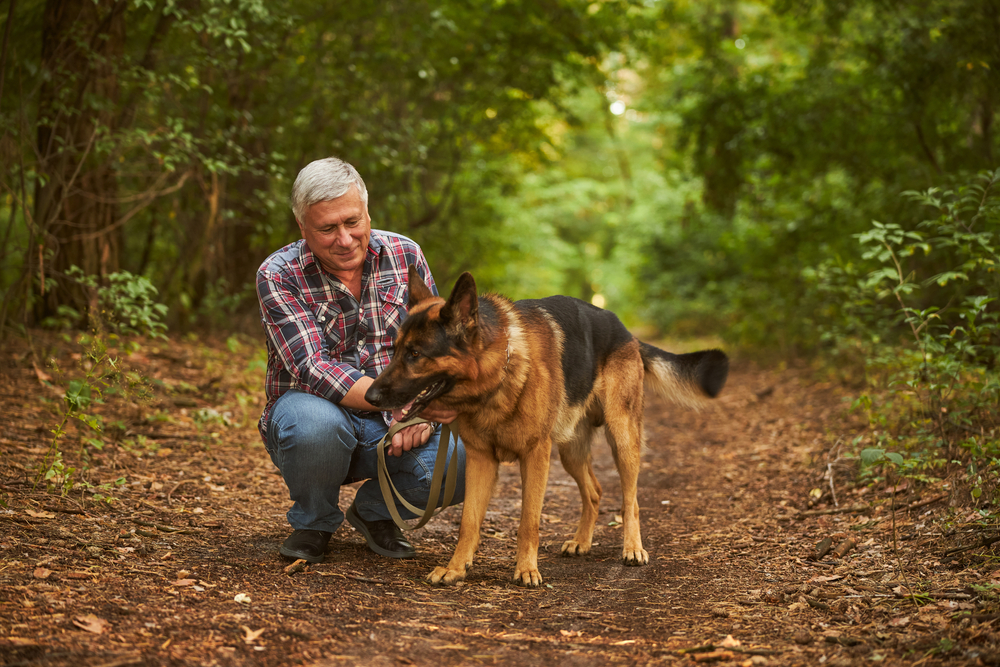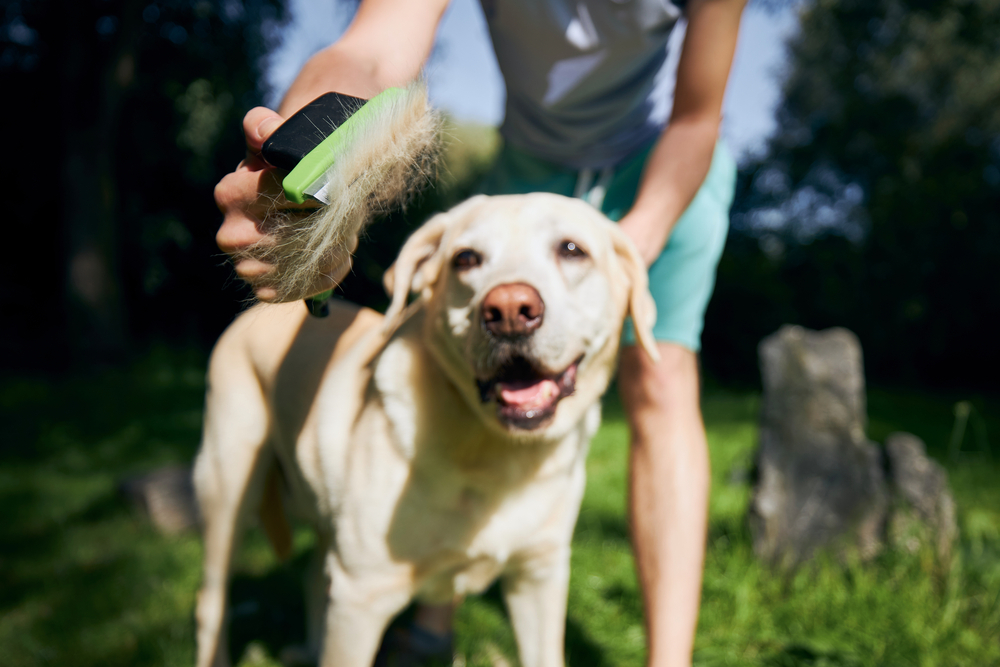Many people believe them… But these are the most common dog myths you MUST stop believing!
Why would anyone feel compelled to make up stuff about dogs when there are plenty of incredible facts about them? For example, did you know that your dog has a dominant paw? So let me ask you this: Is your pup a righty or a lefty?
The truth is, though, there are a ton of mistruths out there about canines, but I’m going to help you get your facts straight.
The next time you’re at the dog park and overhear someone repeating one of these long-standing non-facts, you can confidently say, “Well, ACTUALLY…” before setting them straight. Here are 16 common dog myths everyone takes as facts!
… Bes ure to leave a comment after reading all these to let me know if I missed any!

Common dog myth: You can’t teach an old dog new tricks
You’ve heard this expression before: “You can’t teach an old dog new tricks.” And while it might be true that puppies are like sponges that absorb everything around them, making it effortless to teach them new things, make no mistake, old dogs can still learn new things, according to a certified animal behaviorist.
Of course, some geriatric dogs might struggle with hearing, vision, or mobility issues and might not be as easy to train. Yet, as long as their brain is in good shape, they can learn new things.
Common dog myth: A wagging tail always means a happy dog
Have you ever wondered what your pup’s tail might be trying to tell you? Tail whipping side to side is just one of the ways canines communicate. And even though a wagging tail usually means a happy or excited dog, that’s not always the case.
For instance, an enthusiastic tail wag to the right implies happiness at seeing its human, but slow wags of a tail that are held halfway down can mean insecurity or fear. Also, a tail held very high and wagging extremely fast can mean aggression or fear for some pups.
Common dog myth: Bad dog breath is entirely normal
Bad dog breath is so standard that most folks think it’s just something pet parents live with. But the truth is that your pup’s breath really shouldn’t be that bad. And you should be brushing their teeth more often than you would think. Now, obviously, your dog won’t ever have minty-fresh breath, but it shouldn’t be unbearable either, says a professional dog groomer.
Foul breath is an indicator of underlying health problems. Chronic bad breath is driven by bacteria in the mouth and is frequently the first sign of dental disease.
The biggest offender of bad dog breath is periodontal disease, which impacts up to 80% of dogs by the time they’re 3 years old. In addition to abscesses, tooth loss, and periodontal disease, bad oral hygiene can lead to harmful illnesses, including liver, kidney, and heart damage.
Common dog myth: Dogs eat grass because they feel sick
You’ve probably noticed that your favorite canine pal likes to munch on grass occasionally. They may even go straight for the patch of green the second you take them outside. One of the most common dog tales is that eating grass is a tell-tale sign your dog is feeling sick, but that’s not necessarily the case.
Even though the grass does act as a natural antacid to help make your pup’s belly feel better, dogs eat grass for lots of reasons, some of which have nothing to do with an upset tummy. They could just like the taste of the grass, or they may still be hungry and want to keep eating. Either way, the fibrous grass will fill them up.
Common dog myth: A dry and warm nose means your dog is sick
One of the most common dog myths of them all is about dog sickness symptoms, suggesting that a healthy dog’s nose is always wet and cold. Rest assured that warm and dry noses are entirely normal, though.
So don’t stress if this is the usual state of your dog’s snoot. Everything from allergies and dry air to simply taking a snooze can affect the wetness of your pup’s nose.
But, even though the health of a dog’s nose isn’t normally concerning, if you notice your buddy’s nose is ALWAYS cracking, dry, or running, not just wet, then you should make an appointment with your pup’s veterinarian, just to be on the safe side.

Common dog myth: Rubbing your dog’s nose in an accident stops future accidents
This is one of those common dog myths that does more harm than good. Because canines tend to understand behavioral problems when the behavior happens, rubbing your dog’s nose in an accident when you come home won’t help them make the connection.
When you do this, you’re pretty much punishing a pup that doesn’t know why it’s being punished. This could worsen the problem and create more issues in the future.
The best thing to do is to catch them in the act and redirect them to their proper bathroom destination. Are you struggling with house training? Try the some dog pee pads, and be sure to clean up any accidents with a pet-friendly cleaner because canines often return to spots they’ve previously marked.
Common dog myth: Dogs can only see in black and white
Let’s just be honest: Dogs pretty much have a mind of their own. But they also have eyes of their own and other senses they heavily rely on. And the idea that they only see in black and white is arguably one of the most common dog myths out there.
Canines can see some color, but it’s true that the spectrum is limited. People and most other primates have three kinds of cones in their eyes, making us trichromatic. Well, canines are bichromatic. And because of this, they tend to mix the colors red and green.
Common dog myth: Two puppies at once is best
Adopting two puppies at the same time sounds like a perfectly reasonable approach, right? After all, they’ll have a playmate and won’t ever get lonely! Plus, this method promises many adorable puppy pics. But the truth is that this is one of those common dog myths that could lead to headaches galore!
Think of all those puppy zoomies! From a behavioral and training standpoint, the most significant issue I see with two young puppies being raised together is that they might end up being much more challenging to train. Even if they’re the easiest dog breeds all around, they’re usually so co-dependent on each other that they don’t seem to develop nearly as much as a pup raised properly on its own.
Also, they tend to be distracted by each other, and because their bond is so strong, they have a tendency to place less value on their human relationships.
Common dog myth: Always neuter or spay at a young age
Spaying and neutering pups at a young age was happening at an alarming rate up until a few years ago, and many vets had the view of “the younger, the better,” says a dog trainer. The idea was that early spaying or neutering would stunt behavioral issues as the dog gets older. But sadly, this might be a mistake dog owners are still making.
There are numerous studies that have demonstrated that this is untrue, and waiting to neuter your canine might be safer in the long run. There are also added health benefits for allowing a pet to keep their reproductive organs untouched into adulthood. The pet community is responding to this new data, and more owners and vets are waiting six months to a year to neuter or spay dogs.
Common dog myth: Garlic is a natural tick and flea remedy
When your dog is dealing with ticks or fleas, you’ll more than likely do anything to give them, not to mention your household, some much-needed comfort. If you’ve read that garlic is a natural cure, well, it is. But for humans. To dogs? It’s highly toxic and one of the foods canines can’t eat. So you’ll want to keep it away from your adorable pooch.
Garlic will not only have no effect on fighting off ticks and fleas, but it can also lead to a serious disease called Immune Mediated Hemolytic Anemia (IMHA), according to vets.
Even though it’s a rare disease, IMHA causes the body to erase its own red blood cells, leading to life-threatening anemia. By feeding your dog garlic, you’re unnecessarily risking their health, multiple blood transfusions, and expensive hospital bills.

Common dog myth: Short-haired dogs don’t require grooming
When people think of dog grooming, they usually think of haircuts. So, it’s easy to presume that just long-haired dogs need regular care. But that’s one of those common dog myths that’s actually bad for their health. The truth is that whether you choose to see a professional or groom your pup at home, every canine requires grooming to maintain optimal health.
All dogs need routine care, like ear cleaning, nail clipping, bathing, and teeth brushing, to stay comfortable, clean, and healthy. Long nails aren’t just rackety or unappealing. They can affect your dog’s overall comfort and health.
Routine ear checks and cleaning can guarantee that your dog is free of parasites while bathing and brushing removes dander and loose hair. Basic hygiene and grooming services aren’t just luxuries that are meant for special occasions. They’re crucial to maintaining your pup’s overall wellness and health.
How do you clean YOUR pup’s chompers? If you’ve been lacking in that area and don’t know what to buy, check out this Arm & Hammer Tartar Control Kit for Dogs from Amazon!
Common dog myth: If you meet a dog, let it sniff your hand
Now listen, this is a very well-intentioned line of thinking, though it’s still a common dog myth nevertheless. You shouldn’t stick your hand out toward any canine you’ve just met. In our human interactions, it’s obviously second nature to offer a fist bump or a handshake when meeting someone, but we must remember that dogs aren’t humans.
Sticking out your hand can be mistaken as a sign of aggression, and a canine might bite you. The best thing to do is to calmly wait for the pup to approach you if it’s interested. You don’t know anything about their obedience record, after all. So, if you have to approach a new dog, do it from the side and avoid making eye contact.
Common dog myth: You can use dog treats to bribe your pup
Sure, they might taste good, and your pooch might always beg for them, but dog treats aren’t just an easy way to bribe your furry pal into following your commands. The finest dog trainers view treats as rewards, not bribes. Treats are a fantastic way to show your canine that their consistently good behavior or listening will be positively reinforced with a reward, says a professional dog trainer.
When training our pups’ behaviors, we want to think about when we should give them their treats. If you’re giving them treats before lousy behavior happens, that would be considered a bribe. But, after they do something good, like coming when called or dropping something they shouldn’t be chewing on, you should definitely dig into that treat bag for a job well done.
The bottom line here is that dog treats are an outstanding training tool for young pups. Combine it with a few other training techniques, and you’ll have an all-star pup in no time at all!
Common dog myth: Dogs yawn when they’re tired
Canines are highly emotional, which will undoubtedly affect their behaviors. Have you ever wondered why canines sigh? If you catch your pup mid-yawn, you probably assume it’s feeling tired and ready for a nap. But that’s a reason why humans yawn.
Yawning is normal in dogs, and while they may yawn when tired, dogs also yawn due to anxiety, stress, boredom, or when they want to get away with something.
For instance, I’ve noticed that my fluff ball will yawn when he has to sit still on the couch while we’re eating in the dining room. Dogs will also yawn during a vet visit due to anxiety or wanting to leave the office. Remember that doggy lulls can lead to behavioral issues if you notice you have a bored dog.
Common dog myth: It’s important to show them who’s boss
Well-known as the alpha wolf theory, it became a popular dog training technique after wolves were first studied in captivity. But, as time went on, humans have learned that dominance isn’t necessarily the best way to go. Later studies of wild wolves revealed that packs are simply families, with the older wolves caring for and guiding the younger ones through life until they’re old enough to leave.
Dog trainers nowadays use behavioral principles to look at the precursors and outcomes of behavior, managing the environment, enrichment and exercise, meeting canine needs for social time, and teaching pups what we want them to do, instead of just punishing them when they’ve done something wrong.

Common dog myth: The more love they get, the better the dog
What do all canines want? If your answer is love, you’re only partially right. Love is important when fostering a healthy relationship with your pooch and training them well, but don’t confuse love with lacking boundaries. Pets are increasingly seen as part of the family pack, which can be magical.
We constantly want to indulge them by giving them food from the table or the comfiest seat in the house, but that can backfire on you. Like human kids, furry children will do well with boundaries. Without them, you’ll end up with tons of behavioral issues that can include aggression.
Canines don’t think humans are dogs, which means boundaries set by humans are healthy. Overall, gentle guidance and redirection are critical to establishing a mutually respectful bond that benefits both humans and pets.
Were you aware of all these common dog myths? And are you guilty of using some of these practices on your pup? If you have a lovable pooch living in your home, please leave a comment to share your experiences with Pet Compilation.
And if you found this article useful, I also highly recommend reading about 6 Irritating Dog Habits: Here’s Why Your Pup’s Fed Up With You!













One Response